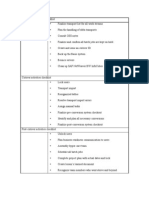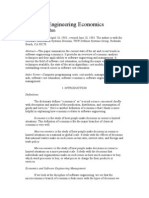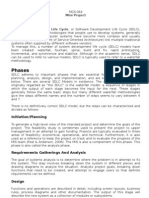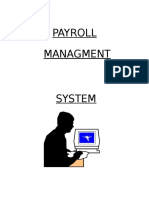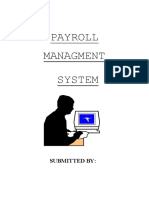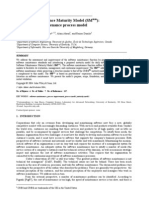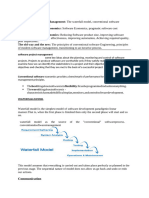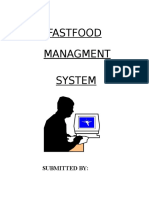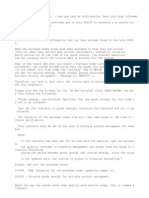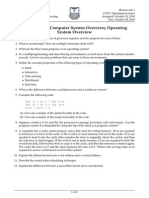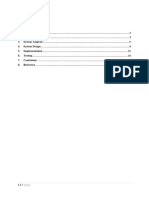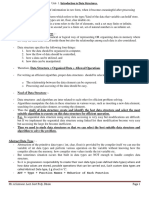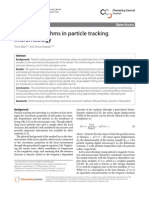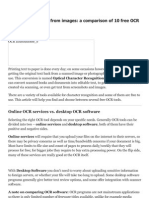Software Engineering Economics: Inresourcn
Software Engineering Economics: Inresourcn
Uploaded by
Patrick SalibaCopyright:
Available Formats
Software Engineering Economics: Inresourcn
Software Engineering Economics: Inresourcn
Uploaded by
Patrick SalibaOriginal Title
Copyright
Available Formats
Share this document
Did you find this document useful?
Is this content inappropriate?
Copyright:
Available Formats
Software Engineering Economics: Inresourcn
Software Engineering Economics: Inresourcn
Uploaded by
Patrick SalibaCopyright:
Available Formats
4
IEEE TRANSACTIONS ON SOFTWARE ENGINEERING, VOL. SE-10, NO. 1, JANUARY 1984
Software Engineering Economics
BARRY W. BOEHM
recent trends in software engineering economics. It provides an overview of economic analysis techniques and their applicability to software engineering and management. It surveys the field of software cost estimation, including the major estimation techniques available, the state of the art in algorithmic cost models, and the outstanding
Abstract-This paper summarizes the current state of the art and
had to determine some key software product feature as a func-
you can think of a number of decision situations in which you
. .
some
research issues in software cost estimation. Index Terms-Computer programming costs, cost models, management decision aids, software cost estimation, software economics,
software engineering, software management.
software life cycle.
engineering economics techniques provide useful assistance. To provide a feel for the nature of these economic decision issues, an example is given below for each of the major phases in the
tion of some limiting critical resource. Throughout the software life cycle,1 there are many decision situations involving limited resources in which software
..
Feasibility Phase: How much should we invest in information system analyses (user questionnaires and interviews, current-system analysis, workload characteriDefinitions zations, simulations, scenarios, prototypes) in order The dictionary defines "economics" as "a social science that we converge on an appropriate definition and concept of operation for the system we plan to impleconcerned chiefly with description and analysis of the producment? tion, distribution, and consumption of goods and services." . Plans and Requirements Phase: How rigorously should Here is another definition of economics which I think is more we specify requirements? How much should we invest helpful in explaining how economics relates to software engiin requirements validation activities (automated comneering. consistency, and traceability hwpolmkdeionpleteness,simulations, prototypes) beforechecks, analytic proceeding to models, in resource-limited situations. design and develop a software system? This definition of economics fits the major branches of classical economics very well.deinadevlpasfwrsytm software we organize classicaloeconomics verythe study of how people make decisions * Product Design Phase: Should ope ic thefeitn t aei osbet s Macroeconomics iS wel softare ic generally ut n completely eetsnu in resource-limited situations on a national or global scale. It ~~~~~~~~software which generally but not completely meets our . . . deals with the effects of decisions that national leaders make interest rates, foreign and trade on such issues as tax rates,'' rqogremintsd Programming Phase: Given a choice between three data policy. . . policy. storage and retrieval schemes which are primarily exeMicroeconomics is the study of how people make decisions cution time-efficient, storage-efficient, and easy-toin resource-limited situations on a more personal scale. It deals modify, respectively; which of these should we choose with the decisions that individuals and organizations make on such issues as how much insurance to buy, which word procsuchissus ashowuch nsuanceto by whch wrd poc-to implement? Test Phase: How much testing and for* Integration and essor to buy, or what prices to charge for their products or mal verification should we perform on a product beservices, fore releasing it to users?
I. INTRODUCTION
inresourcn imicsithe situdyiofs.
~ ~ ~
Economics and Software Engineering Management If we look at the discipline of software engineering, we see that the microeconomics branch of economics deals more with the types of decisions we need to make as software engineers or managers. or managers. Clearly, we deal with limited resources. There is never enough time or money to cover all the good features we would like to put into our software productts. And even in these days
software products must always operate within a world of limited computer power and main memory. If you have been in
the software engineering field for any length of time, I am sure
Manuscript received April 26, 1983; revised June 28, 1983. The author is with the Software Information Systems Division, TRW Defense Systems Group, Redondo Beach, CA 90278.
~~~~~~~~~~~product,utcurts~ re ~~~~~~
Maintenance Phase: Given an extensive list of suggested product improvements, which ones should we implement first? Phaseout: Given an aging, hard-to-modify software should we replace it with a new product, reit, or leave it alone? s
cha an.ita of~~~~~~~~~~~~~~ hadwr eoy
Outline of This Paper ll T o
(cost-benefit
ormr
infcn
analysis, present value analysis, risk analysis, etc.)
lif Economic principles underlie the overall structure of the software liecycle, and its primary refinements of prototyping, incremental development, and advancemanship. The primary economic driver of the life-cycle structure is the significantly increasing cost of making a software change or fixing a software problem, as a function of the phase in which the change or fix is made. See [11, ch. 4] .
0098-5589/84/0100-0004$O1.O0
1984 IEEE
BOEHM: SOFTWARE ENGINEERING ECONOMICS
TO SOFTWARE ENGINEERING ECONOMICS DECISION ANALYSIS TECHNIQUES
DECISION CRITI RIAT DC)
CONVERTIBLE
YEFS
MASTER KEY
Al L \ USFTISTANDARD | MI ZA
O)P
NE TVALUE \/HAPTERS
TION,O
IC,
DECISIO ON
/OUTCOME
HNIGHLY SE jNSI TIVE
13
HAPTFR 17
YFS
Or, if the nondollar objectives can be expressed as constraints (system availability must be at least 98 percent; throughput must be at least 150 transactions per second), then standard
I
As indicated in Fig. 1, standard optimization techniques can be used when we can find a single quantity such as dollars (or pounds, yen, cruzeiros, etc.) to serve as a "universal solvent" into which all of our decision variables can be converted.
/ALI\
vXPRESSIBIE
USE STAND)ARD
X L
OP
HlAP1pF8516
AfNsT s
j |
AI ONl r
rlnn USE LESS
SOLUITION
EXPREPA SINGE
MAKINGS CsIOrrrN (:RlfX IT(.FFCHNIOUFUsSS HIlf
-ES
tJSE
COST-
constrained optimization techniques can be used. And if cash Iflows occur at different times, then present-value techniques can be used to normalize them to a common point in time. More frequently, some of the resulting benefits from the software system are not expressible in dolars. In such situations, one alternative solution will not necessarily dominate
An example situation is shown in Fig. 2, which compares the cost and benefits (here, in terms of throughput in transactions per second) of two alternative approaches to developing an operating system for a transaction processing system.
another solution.
121 l l
O tN - S Dq 00IANTIF iABILI
/ALL U\FRIT | MC LIFIGIJRtFOFFs
CB TFCHNIOUJES (>.HAPT F 17151
TrCHNI()LIFS.
_ _
|USF: IFCHNIOOIES (CHAPTE:R 18)
- . -PRISENT A MIX OF WHEN SAR |PnFSrNT ANO f JTUR CA
C R_ Ol,ANrlFlAH[Ci
FOR
_N NOsecond, using five $1 OK minicomputer processors, be*
TO
1|achieve
Option A: Accept an available operating system. This will require only $80K in software costs, but will
a
peak performance of 120 transactions per
.- -
|{CHAPTER 141
r
USE PRESENT CONVER T
VALUE TECHNIOUFS FUTUIRE S TO PRESENT S
cause of a high multiprocessor overhead factor. Option B: Build a new operating system. This system would be more efficient and would support a higher peak throughput, but would require $180K in softcosts.
I
I
L_-
{WHEN SOE DCs INOLVE ( tlNCERTAINTIES
- - - - - - -- - -
_ _
USE STATISTICAL.
DFCISION THEORY TECHNIOUES (CHAPTERS 19, 201
,_ The
ware
-j
Fig. 1. Master key to software engineering economics decision analysis
techniques.
other, and various cost-benefit decision-making techniques (maximum profit margin, cost/benefit ratio, return on investments, etc.) must be used to choose between Options A and B. In general, software engineering decision problems are even more complex than Fig. 2, as Options A and B will have several important criteria on which they differ (e.g., robustness, ease of tuning, ease of change, functional capability). If these criteria are quantifiable, then some type of figure of merit can be defined to support a comparative analysis of the preferability of one option over another. If some of the criteria are unquantifilable (user goodwill, programmer morale, etc.), then some techniques for comparing unquantifiable criteria need to be used. As indicated in Fig. 1, techniques for each of these situations are available, and discussed in [11].
cost-versus-performance curve for these two options are shown in Fig. 2. Here, neither option dominates the
for dealing with decision issues such as the ones above. Section II of this paper provides an overview of these techniques and their applicability to software engineering. One critical problem which underlies all applications of economic techniques to software engineering is the problem of estimating software costs. Section III contains three major sections which summarize this field: III-A: Major Software Cost Estimation Techniques III-B: Algorithmic Models for Software Cost Estimation III-C: Outstanding Research Issues in Software Cost Estimation. Section IV concludes by summarizing the major benefits of software engineering economics, and commenting on the major challenges awaiting the field.
II. SOFTWARE ENGINEERING ECONOMICS ANALYSIS
TECHNIQUES
Analyzing Risk, Uncertainty, and the Value of Information
Overview ofRelevant Techniques The microeconomics field provides a number of techniques for dealing with software life-cycle decision issues such as the ones given in the previous section. Fig. 1 presents an overall master key to these techniques and when to use them.2
even more complex than those discussed above. This is because the outcome of many of our options cannot be determined in advance. For example, building an operating system with a significantly lower multiprocessor overhead may be achievable, but on the other hand, it may not. In such cir-
~~~~~Insoftware engineering, our decision issues are generally
cumstances, we are faced with a problem of decision making
2 The chapter numbers in Fig. 1 refer to the chapters in [11], in uneucrtiy,whacosdabeikofnudsrd which those techniques are discussed in further detail. outcome.
IEEE TRANSACTIONS ON SOFTWARE ENGINEERING, VOL. SE-10, NO. 1, JANUARY 1984
Senents for option 8
Invsment -
High-payoff -.--- Oiminishing returns
Throughput
200
180
B-Build OS
( transactions ) -sec
lO_ _t
140
120_
100
A-Accept 120~~~~~~~~~~~ availble OS ,-X/
so
40
20
20 40 0 8
00 120
140 160 180
200 220 240
260
280 300
-Co C, I
Fig. 2. Cost-effectiveness comparison, transaction processing system options.
The main economic analysis techniques available to sup- or other information-buying option. (Some examples of the use of Bayes' Law to estimate the appropriate level of investport us in resolving such problems are the following. 1) Techniques for decision making under complete un- ment in a prototype are given in [ 1 1, ch. 20] .) In practice, the use of Bayes' Law involves the estimation certainty, such as the maximax rule, the maximin rule, and the Laplace rule [38]. These techniques are generally inade- of a number of conditional probabilities which are not easy to estimate accurately. However, the Bayes' Law approach can be quate for practical software engineering decisions. 2) Expected-value techniques, in which we estimate the translated into a number of value-of-information guidelines, or probabilities of occurrence of each outcome (successful or conditions under which it makes good sense to decide on inunsuccessful development of the new operating system) and vesting in more information before committing ourselves to a particular course of action. complete the expected payoff of each option: Condition 1: There exist attractive alternatives whose payoff varies greatly, depending on some critical states of nature. EV = Prob(success) * Payoff(successful OS) If not, we can commit ourselves to one of the attractive alter Prob(failure) * Payoff(unsuccessful OS). naie wihn'iko significant loss. natives with no risk of infcn os Condition 2: The critical states of nature have an appreciThese techniques are better than decision making under comable probability of occurring. If not, we can again commit ourn plete uncertainty, but they still involve a great deal of risk if ~~~~~selves without . r. i > higher than our estimate of it. .. major risk. For situations with extremely high the Prob(failure) is considerably 3) Techniques in which we reduce uncertainty by buying variations in payoff, the appreciable probability level is lower than in situations with smaller variations in payoff. . information. For example, prototyping is a way ,.of buying in, success ~~~~~Condition 3: The investigations have a high probability of , '. formation to reduce our uncertainty about the likely identifying the occurrence of the critical states of filue o aultprocsso opratng yste; b ororfilue ofamltipocesoropertin sysem;by dvelpin If not, the investigations will not do much to reduce a rapid prototype of its high-risk elements, we can get a clearer risk t r rs our r of loss due to making the wrong decision. X * picture of our likelihood of successfully developing the full o Condition 4: The required cost and schedule of the investigations do not overly curtail their net value. It does us little In general, prototyping and other options for buying m good to obtain results which cost more than they can save us, formation3 are most valuable aids .for software engineering. de- ~~~~~~~~~~~~or too late to help us make a decision. which arrive . .. cisionsHoevr the . cisions. However, they always raise the folllowueting a___ue.st7 -r.. benefits Condition 5: There exist significant side --. derived . "how much information-buying iS enough?" In principle, this question can be answered via statistical de- fro pefrmn th netgtos gan emyb bet ciio thor tehiqe inovn th us ofBysa,wihjustify an investigation solely on the basis of its value in trainallwst s cacultetheexpctepaof fro a sfwre mg, team-building, customer relations, or design validation. project as a function of our level of investment in a prototype Some Pitfalls Avoided by Using the Value-of-Informnation Approach The guideline conditions provided by the value-of-informa3 Other examples of options for buying information to support
deeloingaccurately nalture.
alasrietefolwnausin
software engineering decisions include feasibility studies, user sur-
niques.
veys, simulation, testing, and mathematical program verification tech- to
to
prahpoieu ihaprpciewihhlsu avoid some serious software engineering pitfalls. The pitfalls
prahpoieu
ihaprpciewihhlsu
BOEHM: SOFTWARE ENGINEERING ECONOMICS
derived from global properties of the software product. The Summary:The Econmic Vale of Infrmationtotal cost iS then split up among the various components. Let us step back a bit from these guidelines and pitfalls. Put 7) Bottom-Up: Each component of the software job is simply, we are saying that, as software engineers: separately estimated, and the results aggregated to produce "It is often worth paying for information because it an estimate for the overall job. helps us make better decisions." The main conclusions that we can draw from Table I are If we look at the statement in a broader context, we can see the following. that it is the primary reason why the software engineering fileld . None of the alternatives is better than the others from exists. It is what practically all of our software customers say all aspects. when they decide to acquire one of our products: that it is * The Parkinson and price-to-win methods are unacceptworth paying for a management information system, a weather able and do not produce satisfactory cost estimates.
below are expressed in terms of some frequently expressed but faulty pieces of software engineering advice. Pitfall 1: Always use a simulation to investigate the feasibility of complex realtime software. Simulations are often extremely valuable in such situations. However, there have been a good many simulations developed which were largely an expensive waste of effort, frequently under conditions that would have been picked up by the guidelines above. Some have been relatively useless because, once they were built, nobody could tell whether a given set of inputs was realistic or not (picked up by Condition 3). Some have been taken so long to develop that they produced their first results the week after the proposal was sent out, or after the key design review was completed (picked up by Condition 4). Pitfall 2: Always build the software twice. The guidelines indicate that the prototype (or build-it-twice) approach is often valuable, but not in all situations. Some prototypes have been built of software whose aspects were all straightforward and familiar, in which case nothing much was learned by building them (picked up by Conditions 1 and 2). Pitfall 3: Build the software purely top-down. When interpreted too literally, the top-down approach does not concern itself with the design of low level modules until the higher levels have been fully developed. If an adverse state of nature makes such a low level module (automatically forecast sales volume, automatically discriminate one type of aircraft from another) impossible to develop, the subsequent redesign will generally require the expensive rework of much of the higher level design and code. Conditions 1 and 2 warn us to temper our top-down approach with a thorough top-to-bottom software risk analysis during the requirements and product design phases. Pitfall 4: Every piece of code should be proved correct, Correctness proving is still an expensive way to get information on the fault-freedom of software, although it strongly satisfies Condition 3 by giving a very high assurance of a program's correctness. Conditions 1 and 2 recommend that proof techniques be used in situations where the operational cost of a software fault is very large, that is, loss of life, compromised national security, major financial losses. But if the operational cost of a software fault is small, the added information on fault-freedom provided by the proof will not be worth the investment (Condition 4). Pitfall 5: Nominal-case testing is sufficient. This pitfall is just the opposite of Pitfall 4. If the operational cost of potential software faults is large, it is highly imprudent not to perform off-nominal testing.
forecasting system, an air traffic control system, an inventory control system, etc.,because it helps them make better decisions. Usually, software engineers are producers of management information to be consumed by other people, but during the software life cycle we must also be consumers of management information to support our own decisions. As we come to appreciate the factors which make it attractive for us to pay for processed information which helps us make better decisions as software engineers, we will get a better appreciation for what our customers and users are looking for in the information processing systems we develop for them.
1II. SOFTWARE COST ESTIMATION
Introduction All of the software engineering economics decision analysis techniques discussed above are only as good as the input data we can provide for them. For software decisions, the most critical and difficult of these inputs to provide are estimates of the cost of a proposed software project. In this section, we will summarize: 1) the major software cost estimation techniques available, and their rel-ative strengths and difficulties; 2) algorithmic models for software cost estimation; 3) outstanding research issues in software cost estimation.
A. Major Software Cost Estimation Techniques Table I summarizes the relative strengths and difficulties of the major software cost estimation methods in use today. 1) Algorithmic Models: These methods provide one or more algorithms which produce a software cost estimate as a function of a number of variables which are considered to be the major cost drivers. 2) Expert Judgment: This method involves consulting one or more experts, perhaps with the aid of an expert-consensus mechanism such as the Delphi technique. 3) Analogy: This method involves reasoning by analogy with one or more completed projects to relate their actual costs to an estimate of the cost of a similar new project. 4) Parkinson: A Parkinson principle ("work expands to fill the available volume") is invoked to equate the cost estimate to the available resources. 5) Price-to-Win: Here, the cost estimate is equated to the price believed necessary to win the job (or the schedule believed necessary to be first in the market with a new product,
etc.). 6) Top-Down: An overall cost estimate for the project is
IEEE TRANSACTIONS ON SOFTWARE ENGINEERING, VOL. SE-10, NO. 1, JANUARY 1984
TABLE I
STRENGTHS AND WEAKNESSES OF SOFTWARE
COST-ESTIMATION METHODS
Strengths
Method Algonthmic model
Weaknesses
*
* Objective, repeatable, analyzable * Efficient, good for sensitivity * Objectivety calibrated to expenence * Assessment of representativeness,
formula
analysis
* Subjective inputs Assessment of exceptional circumstances * Calibrated to past, not
Expert judgment
Analogy
circumstances
interactions, exceptional
future No better than participants * Biases, incomplete recall
Parkinson Price to win
* Based on representative expenence * Correlates with some experience * Often gets the contract
* System level focus * Efficient
* Representativeness of experience
* Reinforces poor practice * Generally produces large overruns
* *
Top-down
Less detailed basis Less stable
Bottom-up
* More detailed basis * More stable * Fosters individua commitnent
* May overtook system level costs * Requires more effort
,,-data sources to support
\
Classes of people,
hamachine Interface
xample sources of uncer
2x 2x
t. 5x * 1.25x_
~~~~Query types, data loads, \ intelligent-terminal tradeoffs, / response times \ / ~~~~~~Internal data structure, /buffer handling techniques
J ~~~~~~~~error handling
/
Detailed scheduling algorithms,
Programmer understanding
_.8x
a
0.67x
0.5x
0.25x
Concept of
operation
Feasibility
Plans and requirements
Product Detailed Requirements design design specifications specifications specifications A A ala
Product
design
Detailed
design
software A Development and test
Accepted
Phases and milestones
Fig. 3. Software cost estimation accuracy versus phase.
with respect to a human-machine interface component of the software. When we first begin to evaluate alternative concepts for a new software application, the relative range of our software cost estimates is roughly a factor of four on either the high or low side.4 This range stems from the wide range of uncertainty where they differ. we have at this time about the actual nature of the product. For the human-machine interface component, for example, Fundamental Limitations of Software Cost Estimation we do not know at this time what classes of people (clerks, Techniques Whatever the strengths of a software cost estimation tech- computer specialists, middle managers, etc.) or what classes of data (raw or pre-edited, numerical or text, digital or analog) the ilhv ospot ni epndw uhucr compensate for our lack of definition or understanding of the sse be done Until softwae speciicationis full tainties, a factor of four in either direction 15 not surprising as dfndiaculyrpeetaragofsoftware jobduto fsfwr rdcs a range of estimates. deind The above uncertainties are indeed pinned down once we and a corresponding range of software development costs. Thisfundmenal lmitaionof sftwae cst etimaion complete the feasibility phase and settle on a particular concept of oafco ftoi ihrdrcin hsrnei technology is illustrated in Fig. 3, which shows the accuracy rnnse operation. At this stage, the range of our estimates diwithin which software cost estimates can be made, as a func-
* The strengths and weaknesses of the other techniques are complementary (particularly the algorithmic models versus expert judgment and top-down versus bottom-up). * Thus, in practice, we should use combinations of the above techniques, compare their results, and iterate on them
itatal'ersnsarag
tion of the software life-cycle phase (the horizontal axis), or of the level of knowledge we have of what the software is in-
tended to do. This level of uncertainty is illustrated in Fig. 3
4Teerne aebe eemndsbetvl,adaeitne to represent 80 percent confidence limits, that is, "within a factor of
four on either side, 80 percent of the time."
BOEHM: SOFTWARE ENGINEERING ECONOMICS
reasonable because we still have not pinned down such issues as the specific types of user query to be supported, or the specific functions to be performed within the microprocessor in the intelligent terminal. These issues will be resolved by the time we have developed a software requirements specification, at which poinlt, we will be able to estimate the software costs within a factor of 1.5 in either direction. By the time we complete and validate a product design specification, we will have resolved such issues as the internal data structure of the software product and the specific techniques for handling the buffers between the terminal microprocessor and the central processors on one side, and between the microprocessor and the display driver on the other. At this point, our software estimate should be accurate to within a factor of 1.25, the discrepancies being caused by some remaining sources of uncertainty such as the specific algorithms to be used for task scheduling, error handling, abort processing, and the like. These will be resolved by the end of the detailed design phase, but there will still be a residual uncertainty about 10 percent based on how well the programmers really understand the specifications to which they are to code. (This factor also includes such consideration as personnel turnover uncertainties during the development and test phases.)
B. Algorithmic Models for Software Cost Estimation Algorithmic Cost Models: Early Development Since the earliest days of the software field, people have been trying to develop algorithmic models to estimate software costs. The earliest attempts were simple rules of thumb, such as: such as: * on a large project, each software performer will provide an average of one checked-out instruction per man-hour (or roughly 150 instructions per man-month); * each software maintenance person can maintain four boxes of cards (a box of cards held 2000 cards, or roughly 2000 instructions in those days of few comment cards). Somewhat later, some projects began collecting quantitative data on the effort involved in developing a software product, and its distribution across the software life cycle. One of the earliest of these analyses was documented in 1956 in [8] . It indicated that, for very large operational software products on the order of 100 000 delivered source instructions (100 KDSI), that the overall productivity was more like 64 DSI/man-month, that another 100 KDSI of support-software would be required; that about 15 000 pages of documentation would be produced and 3000 hours of computer time consumed; and that the distribution of effort would be as follows:
progress was made in software cost estimation, while the frequency and magnitude of software cost overruns was becoming critical to many large systems employing computers. In 1964, the U.S. Air Force contracted with System Development Corporation for a landmark project in the software cost estimation field. This project collected 104 attributes of 169 software projects and treated them to extensive statistical analysis. One result was the 1965 SDC cost model [41] which was the best possible statistical 13-parameter linear estimation model for the sample data:
MM = -33.63 +9.15 (Lack of Requirements) (0-2)
10.73 (Stability of Design) (0-3) +0.51 (Percent Math Instructions) +0.46 (Percent Storage/Retrieval Instructions)
+0.40 (Number of Subprograms) + 7.28 (Programming Language) (0-1) -21.45 (Business Application) (0-1)
13.53 (Stand-Alone Program) (0.1) + 12.35 (First Program on Computer) ( o C (0-1) g
++58.82 (Concurrent Hardware Development) (0-1)
(Developed ~~~~~~~~~~~~~~-25.20 by Military Organization) (0-1).
+30.61 (Random Access Device Used) (0-1) +29.55 (Difference Host, Target Hardware) (0-1) +0.54 (Number of Personnel Trips)
The numbers in parentheses refer to ratings to be made by the estimator. When applied to its database of 169 projects, this model produced a mean estimate of 40 MM and a standard deviation of 62 MM; not a very accurate predictor. Further, the application of the model is counterintuitive; a project with all zero ratings is estimated at minus 33 MM; changing language from a higher order language to assembly language adds 7 MM, independent of project size. The most conclusive result from the SDC study was that there were too many nonlinear aspects of software development for a linear cost-estimation model to work very well. Still, the SDC effort provided a valuable base of information and insight for cost estimation and future models. Its cumulative distribution of productivity for 169 projects was a valuable aid for producing or checking cost estimates. The estimaProgram Specs: 10 percent tion rules of thumb for various phases and activities have been Coding Specs: 30 percent very helpful, and the data have been a major foundation for Coding: 10 percent some subsequent cost models. Parameter Testing: 20 percent In the late 1960's and early 1970's, a number of cost models Assembly Testing: 30 percent were developed which worked reasonably well for a certain restricted range of projects to which they were calibrated. Some with an additional 30 percent required to produce operational of the more notable examples of such models are those despecs for the system. Unfortunately, such data did not become scribed in [3], [54], [57] . well known, and many subsequent software projects went The essence of the TRW Wolverton model [57] is shown in through a painful process of rediscovering them. Fig. 4, which shows a number of curves of software cost per During the late 1950's and early 1960's, relatively little object instruction as a function of relative degree of difficulty
10
IEEE TRANSACTIONS ON SOFTWARE ENGINEERING, VOL. SE-10, NO. 1, JANUARY 1984
8C
Categories
C
70
= Control I =Input/output P =Pre/post processor 70A =Algor thm D =Data management T = Time critical processor
T (all)
Category Ctgr
(D) N
60
Sample range excludes upper and lower
20 percentiles
0 50-
10
-0
40-
30
-()L
")OLD
New
20Old
A1OLD
Easy
Medium Hard
20
40 60 80 Relative degree of difficulty percent of total sample experiencing this rate or less
tOO
Fig. 4. TRW Wolverton model: Cost per object instruction versus relative degree of difficulty.
(0 to 100), novelty of the application (new or old), and type where of project. The best use of the model involves breaking the Ss = number of delivered source instructions software into components and estimating their cost individuK = life-cycle effort inman-years ally. This, a 1000 object-instruction module of new data mantd = development time in years agement software of medium (50 percent) difficulty would be Ck = a "technology constant." costed at $46/instruction, or $46 000.
This model is well-calibrated to a class of near-real-time Values of Ck typically range between 610 and 57 314. The government command and control projects, but is less ac- current version Qf SLIM allows one to calibrate Ck to past In curate for some other classes of projects. *addition,' the or to past projects or to estimate it as a function of a modelactivity. a good breakdown of project effort by phase o~~~~rojects use of modern programming practices, hardware conprovides project's and activity. straints personnel experience, interactive development, and In the late 1970's, several software cost estimation models other ~~~~~~~~factors. The required development effort, DE, is esti' peren thelife-c effort fo large were developed which established a significant advance in the mted as.ruhl ogy4 ecn f h iecceefr o ag included state of the art. These includd the Putnam SLIModel Putnam systems. For smaller systems, the percentage varies as a funcm Model the Doty Model [27], the theR PRICE S model [22], the to of system size. RCA tion fsse ie COCOMO model the IBM-FSD model [53], the Boeing COCOMO model [I1 ] [11],theIBM-FSDmoel[53],theBoThe SLIM model includes a number of useful extensions to s q model [9], and a series of models developed by GRC [15]. A e . summary of these models, and the earlier SDC and Wolverton major-milestone schedules, relability levels, computer time, models, is shown' in Table II,' in terms of the size,' program,' ~~~~~~~~~~and documentation costs. The mostacontrosiod computer, personnel, and project attributes used by each The most controversial aspect of the SLIM model is its n e model to mode todetnnie software costs. Th first four of these taef eainhpbtendvlpetefr determine sotwae csts The firt fur f tese tradeoff relationship between development effort K and bemodels are discussed blw below. moes r tween development time td. For a software product of a given size, the SLIM software equation above gives The Putnam SLIMModel [44], [45] cntn The Putnam SLIM Model is a commercially available (from K= Quantitative Software Management, Inc.) software product 4 based on Putnam's analysis of the software life cycle in terms td of the Rayleigh distribution of project personnel level versus For example, this relationship says that one can cut the time. The basic effort macro-estimation model used in SLIM is cost of a software project in half, simply by increasing its development time by 19 percent (e.g., from 10 months to 12 months). Fig. 5 shows how the SLIM tradeoff relationship comS5= CkK 1/3 tg'3
state Dofthe art.oThese
SLM
[44],mtda [44],t
.b.f
dsuse*
BOEHM: SOFTWARE ENGINEERING ECONOMICS
TABLE II
11
FACTORS USED IN VARIOUS COST MODELS
SDC,
TRW, PUTNAM,
1972 SLIM DOTY X X
GROUP
SIZE ATTRIBUTES
FACTOR
SOURCE INSTRUCTIONS OBJECT INSTRUCTIONS NUMBER OF ROUTINES NUMBER OF DATA ITEMS NUMBER OF OUTPUT FORMATS
1965
RCA, PRICE S
X X
BOEING,
IBM X 1977
GRC,
1979
COCOMO
X
SOFCOST DSN X X X
X X
JENSEN
X
X X X X
X X
DOCUMENTATION NUMBER OF PERSONNEL
PROGRAM ATTRIBUTES
TYPE COMPLEXITY LANGUAGE
X
X
X X X X
x x x X X
x
x x
X X x x
x
x X x X
X X x x x X X X X X
x x X
X X
x X X X
REUSE REQUIRED RELIABILITY DISPLAY REQUIREMENTS
X X X X X X X
x X
X X x x
COMPUTER ATTRIBUTES
PERSONNEL ATTRIBUTES
PROJECT ATTRIBUTES
TIME CONSTRAINT STORAGE CONSTRAINT HARDWARE CONFIGURATION CONCURRENT HARDWARE DEVELOPMENT INTERFACING EQUIPMENT, S/W PERSONNEL CAPABILITY PERSONNEL CONTINUITY HARDWARE EXPERIENCE APPLICATIONS EXPERIENCE LANGUAGE EXPERIENCE TOOLS AND TECHNIQUES
X X X
X X
X)
x X X
X
X X x x X X
X X X X X X
X x
x x
x x
X X
X X
X X X
x X X X X X X X X X X
X X
X X X X
x X X X
xi
X
X)
X
x X X X
CUSTOMER INTERFACE REQUIREMENTS DEFINITION REQUIREMENTS VOLATILITY
SCHEDULE SECURITY
X X X
X X
X
X X X X
X X
X X
X
COMPUTER ACCESS TRAVEL/REHOSTING/MULTI-SITE SUPPORT SOFTWARE MATIJRITY
X X X
1,047 0.91 1.0
x X X x x x X X X X X X X X X X
X
x X X X X X X X X
CALIBRATION FACTOR
EQUATION
MMNOM = C(DSIX, X
1.0
1.05-1.2
0.32 - 0.38
1.0
1.2
SCHEDULE EQUATION
tD
lMM)X, X =0-35
JENSEN
\
0.356
0.333
1.4
SPRICE S
COCOMO
SLIM |
1.3
DSN
1.2i
1.1
RELATIVE EFFORT 1.C MMNOM 0.6 0.7
0.8
0.9
1.0
\s "
\\
'11
s
1.2
~~~RELATIVE SCHEDULE
1.3
1.4
~~~TDESIRED,TNOM 0.9 \ L'_~ ~ ~ ~ ~ ~ ~ ~S _
Fig. 5.
Comparative effort-schedule tradeoff relationships.
12
IEEE TRANSACTIONS ON SOFTWARE ENGINEERING, VOL. SE-10, NO. 1, JANUARY 1984
TABLE III DOTY MODEL FOR SMALL PROGRAMS*
MM = 2.060
P-"
Factor
Yes
s
No
1.11
r_eshae versus batch si
,i dev_lopment Develop using cmAputer at aier facity Development at o al ss an Deveokpment compuWo differt VW
Fkst stware developed on CPUJ CorentdevelopmeoDP hardware
Spe dsply Dtaled definitIon of operatonal require Chawge to opati requiet Real-tm operatin CPUJ memory conin CPU *me cn t
& 4
f,
f 4 4.
11.33
1.05 1.33 1.43
1.11 1.00
1.00
1.92 1.82
1.00 1.00 1.00 1.00 1.00 1.00
Devepment at mowe Fan one sit
Progremmer MM aoom to a~~~ss to
ni
comuter
fU
f, .fu
t
0.83 1.43 1.39
125 1.25
1.00 1.00 1.00
1.00 1.00 1.00 0 90
~4'
4
Utilization
UrLknted
* L.aa Vw 10,000 soume kicians
pares with those of other models; see [11, ch. 27] for further
On balance, the SLIM approach has provided a number of useful insights into software cost estimation, such as the Rayleigh-curve distribution for one-shot software efforts, the explicit treatment of estimation risk and uncertainty, and the cube-root relationship defining the minimum development time achievable for a project requiring a given amount of effort.
The Doty Model [27] This model is the result of an extensive data analysis activity, including many of the data points from the SDC sample. A number of models of similar form were developed for different application areas. As an example, the model for general application is
discussion of this issue.
Normalized
1.08 1.21 1 47 1.73 225
0.60 , -o 070
0.50
cost 1.00
Normalized
schedule 1.00
1.00
2
z
2 0,95
090
0.85
0.80
1.10
1 00 1 05
1,35
Cost
~~3.78
1.18
Sched l
05 06 07 0.8 0.9 1.0 Utilization of 3vailable speed and memory Fig. 6. RCA PRICE S model: Effect of hardware constraints. 04
PRICE S has extended a number of cost-estimating relationships developed in the early 1970's such as the hardware constraint function shown in Fig. 6 [10]. It was primarily developed to handle military software projects, but now also includes rating levels to cover business applications. PRICE S also provides a wide range of useful outputs on gross phase and activity distributions analyses, and monthly project cost-schedule-expected progress forecasts. Price S uses a two-parameter beta distribution rather than a Rayleigh curve to calculate development effort distribution versus calendar time. PRICE S has recently added a software life-cycle support cost estimation capability called PRICE SL [34].- It involves the definition of three categories of support activities. * Growth: The estimator specifies the amount of code to be added to the product. PRICE SL then uses its standard techniques to estimate the resulting life-cycle-effort distribution. * Enhancement: PRICE SL estimates the fraction of the existing product which will be modified (the estimator may
for KDSI > 10 / 14 \ MM = 2.060 (KDSI)' .047 ( fH J, for KDSI < 10. / =
The effort multipliers fi are shown in Table III. This model has a much more appropriate functional form than the SDC model, but it has some problems with stability, as it exhibits a discontinuity at KDSI = 10, and produces widely varying estimates via the f factors (answering "yes" to "first software developed on CPU" adds 92 percent to the estimated cost).
MM = 5.288 (KDSI)l 047,
The RCA PRICE SModel [22] PRICE S is a commercially available (from RCA, Inc.) macro cost-estimation model developed primarily for embedded system applications. It has improved steadily with experience; earlier versions with a widely varying subjective complexity factor have been replaced by versions in which a number of computer, personnel, and project attributes are used to modulate the complexity rating.
BOEHM: SOFTWARE ENGINEERING ECONOMICS
13
provide his own fraction), and uses its standard techniques to estimate the resulting life-cycle effort distribution. * Maintenance: The estimator provides a parameter indicating the quality level of the developed code. PRICE SL uses this to estimate the effort required to eliminate remaining errors.
TABLE IV COCOMO SOFTWARE DEVELOPMENT MODES Mode Feature Semidetached Embedded Organic Organizational understanding of
product objectives Experience in working with related software systems
Thorough
Extensive
Basic
Considerable Considerable Considerable
General
Moderate
Full
The COnstructive COst MOdel (COCOMO) [11] The primary motivation for the COCOMO model has been to help people understand the cost consequences of the decisions they will make in commissioning, developing, and supporting a software product. Besides providing a software cost estimation capability, COCOMO therefore provides a great deal of material which explains exactly what costs the model is estimating, and why it comes up with the estimates it does. Further, it provides capabilities for sensitivity analysis and of engineering tradeoff analysis of many of the common software many of the
Need for software conformance
with pre-established requirements
with external interface specifications Concurrent development of associNeed for innovative data processing
Need for software conformance
Basic
Considerable
Full
tional procedures
new
dev
and ofea-
Some
Minimal Low <50 KDSI
Batch data
Moderate
Some Medium <300 KDSI
Most transaction
Extensive
Considerable High All sizes
Large, complex
architectures, algorithms Premium on early completion Product size range
Examples
Scmodtils
Business ~~~~~~
Familiar
reduction
processing sys-
NewOS,DBMS
COCOMO is actually a hierarchy of three increasingly detailed models which range from a single macro-estimation scaling model as a function of product size to a micro-estimation model with a three-level work breakdown structure and a set of phase-sensitive multipliers for each cost driver attribute. To provide a reasonably concise example of a current state of the art cost estimation model, the intermediate level of COCOMO is described below. Intermediate COCOMO estimates the cost of a proposed software product in the following way. 1) A nominal development effort is estimated as a function of the product's size in delivered source instructions in thousands (KDSI) and the project's development mode. 2) A set of effort multipliers are determined from the product's ratings on a set of 15 cost driver attributes. 3) The estimated development effort is obtained by multiplying the nominal effort estimate by all of the product's effort multipliers. 4) Additional factors can be used to determine dollar costs, development schedules, phase and activity distributions, computer costs, annual maintenance costs, and other elements from the development effort estimate. Step 1-Nominal Effort Estimation: First, Table IV is used to determine the project's development mode. Organic-mode projects typically come from stable, familiar, forgiving, relatively unconstrained environments, and were found in the COCOMO data analysis of 63 projects have a different scaling equation from the more ambitious, unfamiliar, unforgiving, tightly constrained embedded mode. The resulting scaling equations for each mode are given in Table V; these are used to determine the nominal development effort for the project in man-months as a function of the project's size in KDSI and the project's development mode. For example, suppose we are estimating the cost to develop the microprocessor-based communications processing software for a highiy ambitious new electronic funds transfer network with high reliability, performance, development schedule, and interface requirements. From Table IV, we determine that these characteristics best fit the proffile of an embedded-mode project. We next estimate the size of the product as 10 000 delivered
decision issues.
~ Ambitious inventory, production
Simple command-
Simple inven-
OS, compiler
~ ~control~ ~ ~ ~ ~models ~~~~
control
transaction spystems
tory, produc-
Ambitious, very large OS Avionics Ambitious command-control
ton'control
TABLE V COCOMO NOMINAL EFFORT AND SCHEDULE EQUATIONS NOMINAL EFFORT SCHEDULE DEVELOPMENT MODE
Organic
(MMNOM = 3.2(KDSI) 1-05 TDEV = 2.5(MMDEV)
38
Semidetached
Embedded
(21NO)s = 3.0(KDSI) 1.12 TDEV =2.5(M,DEV) 0.35
1tl'lNOM 2.8(KDSI)1
20
TDEV = 2.5(NDEV0.32
(KDSI = thousands of delivered source instructions)
source instructions, or 10 KDSI. From Table V, we then determine that the nominal development effort for this Embeddedmode poet is
2.8(10)1 .20 = 44 man-months (MM).
Step 2-Determine Effort Multipliers: Each of the 15 cost driver attributes in COCOMO has a rating scale and a set of effort multipliers which indicate by how much the nominal effort estimate must be multiplied to account for the project's having to work at its rating level for the attribute. These cost driver attributes and their corresponding effort multipliers are shown in Table VI. The summary rating scales for each cost driver attribute are shown in Table VII, except for the complexity rating scale which is shown in Table VIII (expanded rating scales for the other attributes are provided in [1 1]). The results of applying these tables to our microprocessor communications software example are shown in Table IX. The effect of a software fault in the electronic fund transfer system could be a serious financial loss; therefore, the project's RELY rating from Table VII is High. Then, from Table VI, the effort multiplier for achieving a High level of required reliability is 1.15, or 15 percent more effort than it would take to develop the software to a nominal level of required reliability.
14
IEEE TRANSACTIONS ON SOFTWARE ENGINEERING, VOL. SE-10, NO. 1, JANUARY 1984
TABLE VI INTERMEDIATE COCOMO SOFTWARE DEVELOPMENT EFFORT MULTIPLIERS
Ratgs
Cost Drivers
Very
low
Low
Nominal
1.00 1.00 1.00
High 1.15 1.08 1.15
1.11 1.06 1.15 1.07
86 91 .86 .90 .95 .91 .91 1.04
Very
Extra
High
1.40 1.30
High
Product Attributes RELY Required software reliability DATA Data base size CPLX Product complexity Computer Attributes TIME Execution time constraint STOR Main storage constraint VIRT Virlual machine volatility' TURN Computer turnaround lime
Personnel Attributes ACAP Analyst capability AEXP Applications experience PCAP Programmer capability VEXP Virtual machine experience' LEXP Programming language experience
.75
.70
.88 .94 .85
1.16
1.65 1.66 1.56
.87
1.46 1.21 1.14
.87
1.00 1.00 1.00 1.00
1.30 1.21 1.30 1-15
.71 .82 .70
1.29 1.42
1.10 1.07
1.19 1.13 1.17
1.00 1.00 1.00 1.00
1.00
MODP Use ol modern programming practices TOOL Use of software tools SCED Required development schedule
Project Attributes
1.24 1.24 1.23
1.10
1.10 1.08
1.00
1.00 1.00
.82 .83 1.10
For a given soltwue product. the underlying virtual machine is he complex of hardware and software OS. DBMS, etc.) it calls on to accomplish its tasks
TABLE VII COCOMO SOFTWARE COST DRIVER RATINGS
Ratings
Cost Driver
Product attributes RELY
DATA
CPLX
Very Low
Low
Nominal
High High tinancial loss 100 D < 1000
_
Very
High
Extra High
Effect: slight inconvenience
See Table a
Low, easily recoverable losses <10 Ping
Moderate, recoverable 10 s
Dti
D<100
osses
Risk to human ite
D;p 1000
85% 95%
Computer attributes
TIME
50% use ot avail-
able execution
70%
70%
STOR
VIRT
TURN Pwonnel attributes ACAP
AEXP
15th percentile s4 months ex-
Major change every 12 months Minor: 1 month
Interactive
Major: 6 months Minor 2 weeks
<4 hours
< 50% use o0 available storage
time
85%
95%
Maior: 2 months
Minor: I week
4-12 hours
Major 2 weeks Minor 2 days
>12
Average tumaround
hours
VEXP LEXP
PCAP
perience 15th percentile s1 month expe-
35th percentile 1 year 35th percentile 4 months
4 months
3 years
55th percentile
55th percentile 1 year 1 year
75th percentie 6 years
75th percentile 3 years
3 years
90th percentile 12 years
90th
percentie
rience -1 month expe4ience
Prolieci attributes MOOP
TOOL
No use Basic microprocessor tools
Basic mini tools
Beginning use
Some use
Basic mid/maxi
tools
General use Strong maxi programming. test tools
Routine use Add requiremnea, design.
160%
SCED *'Team xan
75% o1 norninal 85% 100% ae,. idys lweaimme atiy aflonc. qai bo ceatxe and coopaaer
130%
mnaemet. documentation tools
BOEHM: SOFTWARE ENGINEERING ECONOMICS
15
TABLE VIII COCOMO MODULE COMPLEXITY RATINGS VERSUS TYPE OF MODULE
Rabng Very low
Control Operations
Computational
Operations
Device-dependent Operations
Data Management
Operations
Straightiine code with a few nonnested SPooperators: DOs, CASEs, IFTHENELSEs. Simple predicates
Evaluation of simple expressions: e.g., A=B+CC (D - E)
Simple read, wnte
statements with simple formats
Simple arrays in
main memory
Low
Straightforward
simple predicates
nesting of SP operators. Mostly
Evaluation of moderate-level expressions, e.g., D = SORT
(B 2-4. AC)
Nominal
Mostly simple nesting. Some intermodule control. Decision tables
Highly nested SP operators with many compound
Use of standard math and stabstical routines. Basic matrix/vector
operations
No cognizance needed of particular processor or 1/0 device characteristics. 1/0 done at GET/ PUT level. No cognizane of overlap 1/0 processing includes device selection, status checking and error processing
Operations at physical 1/0 level (physical storage address translations: seeks, re Js,
Single file subsetting with no data
structure
changes, no edits, no intermediate files
High
Basic numencal
Very high
dule control. Reentrant and recursive coding.
predicates. . Queue and stack control. Considerable intermo-
analysis: multivariate interpolation, ordinary differentiat equations. Basic truncation, roundoff concems Difficult but structured N.A.: nearsingular matnx equabons, partial differential equations
structural changes, simple edits Special purpose subroutines activated by data
stream contents. ComDlex data restre, turing at record
Multi-file input and single file output. Simple
etc). Optimized
1/0 overlap
level
terrupt handling
Fixed-pnonty in-
Routines for interrupt diagnosis, servcing, masking. Communication line
A generalized, pa-
handling
rameter-driven file structunng routine. File building, com-
mand processing, search optimization
bonal structures. Natural language data management
Extra high
Multiple resource
dynamically changing pnonbes. Microcodelevel control
scheduling with
Difficult and unstructured N.A.: highly accurate analysis of noisy, stochastic data
Device timing-dependent coding,
micro-programmed operabons
Highly coupled, dynamic rela-
&SP structured programming
COCOMO COST DRIVER RATINGS: MICROPROCESSOR COMMUNICATIONS SOFTWARE
Cost Driver RELY DATA CPLX TIME STOR VIRT TU RN ACAP AEXP
PCAP
TABLE IX
Situation
Rating
Effort Multiplier
VEXP
LEX P
MXODP
TOOL SCED
Serious financial consequences of software faults 20,000 bytes Communications processing Will use 70- of available time 45K of 64K store ( 70%) Based on commercial microprocessor hardware Two- hour average tur-na round time Good senior analysts Three years Good senior programmers Six months Twelve months Moat techniques in use over one year At basic minicomputer toot level Nine months
High
Low
Very High High High
Nominal Nominal High Nominal High Low Nominal High Low Nominal
1.15 0.94 1.30
1.11 1. 06
1,00
1.,00
0. 86
1.00 0.86 1.10
1.00 0.91
1.10 1.00
Effort adjustment factor (product of effort multipliers)
1. 35
16
IEEE TRANSACTIONS ON SOFTWARE ENGINEERING, VOL. SE-10, NO. 1, JANUARY 1984
The effort multipliers for the other cost driver attributes are obtained similarly, except for the Complexity attribute, which is obtained via Table VIII. Here, we first determine that communications processing is best classified under device-dependent operations (column 3 in Table VIII). From this column, we determine that communication line handling typically has a complexity rating of Very High; from Table VI, then, we determine that its corresponding effort multiplier is
,=F
2CK _
-
low _
1.30. Step 3-Estimate Development Effort: We then compute the estimated development effort for the microprocessor communications software as the nominal development effort (44 MM) times the product of the effort multipliers for the l5 cost driver attributes in Table IX (1.35, in Table IX). The resulting estimated effort for the project is then (44 MM) (1.35)= 59MM. Step 4-Estimate Related Project Factors: COCOMO has additional cost estimating relationships for computing the resulting dollar cost of the project and for the breakdown of cost and effort by life-cycle phase (requirements, design, etc.) and by type of project activity (programming, test planning, management, etc.). Further relationships support the estimation of the project's schedule and its phase distribution For example, the recommended development schedule can be obtamned from the estimated development man-months via the embedded-mode schedule equation in Table V: TDEV = 2.5(59)0.32 = 9 months. As mentioned above, COCOMO also supports the most common types of sensitivity analysis and tradeoff analysis involved in scoping a software project. For example, from Tables VI and VII, we can see that providing the software developers with an interactive computer access capability (Low turnaround time) reduces the TURN effort multiplier from 1.00 to 0.87, and thus reduces the estimated project effort from 59 MM to (59 MM)~~ (0 87) = 51 MAM '5"M * l59iMM The COCOMO model has been validated with respect to a sample of 63 projects representing a wide variety of business, scientific, systems, real-time, and support software projects. For this sample, Intermediate COCOMO estimates come within 20 percent of the actuals about 68 percent Qf the time (see Fig. 7). Since the residuals roughly follow a normal distribution, this is equivalent to a standard deviation of roughly 20 percent of the project actuals. This level of accuracy is representative of the current state of the art in software cost models. One can do somewhat better with the aid of a calibration coefficient (also a COCOMO option), or within a limited applications context, but it is difficult to improve significantly on this level of accuracy while the accuracy of software data collection remains in the "20 percent" range. A Pascal version of COCOMO is available for a nominal distribution charge from the Wang Institute, under the name WI=
A * %2 A
50 _
xX
x
20A bed E /od
F
idetti
m<x|
xA
lnwmist COCOMOeit onw, Fig. 7. Intermediate COCOMO estimates versus project actuals.
La5
tO
20
50
100
200
SOO
I0
2000
500
1 0.00
scaling equation of the form MMNOM = c(KDSI)X and a set of multiplicative effort adjustment factors determined by a number of cost driver attribute ratings. Some of them use the Rayleigh curve approach to estimate distribution across the software life-cycle, but most use a more conservative effort/ schedule tradeoff relation than the SLIM model. These aspects have been summarized for the various models in Table II and Fig. 5. The Bailey-Basili meta-model [4] derived the scaling equation MMNOM = 3.5 + 0.73 (KDSI)1 .16
and used two additional cost driver attributes (methodology level and complexity) to model the development effort of 18 projects in the NASA-Goddard Software Engineering Laboratory to within a standard deviation of 15 percent. Its accuracy for other project situations has not been determined. The Grumman SOFCOSTModel [19] uses a similar but unpublished nominal effort scaling equation, modified by 30 multiplicative cost driver variables rated on a scale of 0 to 10. Table II includes a summary of these variables. The Tausworthe Deep Space Network (DSN) model [50] uses a linear scaling equation (MMNOM = a(KDSI)l .0) and a similar set of cost driver attributes, also summarized in Table II. It also has a well-considered approach for determining the equivalent KDSI involved in adapting existing software within a new product. It uses the Rayleigh curve to determine the phase distribution of effort, but uses a considerably more consenrative version of the SLIM effort-schedule tradeoff relationship (see Fig. 5). The Jensen model [30], [31] is a commercially available model with a similar nominal scaling equation, and a set of cost driver attributes very similar to the Doty and COCOMO models (but with different effort multiplier ranges); see Table II. Some of the multiplier ranges in the Jensen model vary as functions COMO [18] . of other factors; e.g., increasing access to computer resources widens the multiplier ranges on such cost drivers as personnel Recent Software Cost Estimation Models recent software cost estimation-models tend to capability and use of software tools. It uses the Rayleigh curve Most of thve follow the Doty and COCOMO models in having a nominal for effort distribution, and a somewhat more conservative ef-
BOEHM: SOFTWARE ENGINEERING ECONOMICS
17
fort-schedule tradeoff relation than SLIM (see Fig. 5). As with the other commercial models, the Jensen model produces a number of useful outputs on resource expenditure rates, probability distributions on costs and schedules, etc.
C. Outstanding Research Issues in Software Cost Estimation Although a good deal of progress has been made in software cost estimation, a great deal remains to be done. This section updates the state-of-the-art review published in [ 1 1] , and summarizes the outstanding issues needing further research: 1) Software size estimation; 2) Software size and complexity metrics; 3) Software cost driver attributes and their effects; 4) Software cost model analysis and refinement; 5) Quantitative models of software project dynamics; 6) Quantitative models of software life-cycle evolution; 7) Software data collection. 1) Software Size Estimation: The biggest difficulty in using today's algorithmic software cost models is the problem of providing sound sizing estimates. Virtually every model requires an estimate of the number of source or object instructions to be developed, and this is an extremely difficult quantity to determine in advance. It would be most useful to have some formula for determining the size of a software product in terms of quantities known early in the software life cycle, such as the number and/or size of the files, input formats, reports, displays, requirements specification elements, or design specification elements. Some useful steps in this direction are the function-point approach in [2] and the sizing estimation model of [29], both of which have given reasonably good results for small-to-medium sized business programs within a single data processing organization. Another more general approach is given by DeMarco in [17] . It has the advantage of basing its sizing estimates on the properties of specifications developed in conformance with DeMarco's paradigm models for software specifications and designs: number of functional primitives, data elements, input elements, output elements, states, transitions between states, relations, modules, data tokens, control tokens, etc. To date, however, there has been relatively little calibration of the formulas to project data. A recent IBM study [14] shows some correlation between the number of variables defined in a statemachine design representation and the product size in source instructions. Although some useful results can be obtained on the software sizing problem, one should not expect too much. A wide range of functionality can be implemented beneath any given specification element or I/O element, leading to a wide range of sizes (recall the uncertainty ranges of this nature in Fig. 3). For example, two experiments, involving the use of several teams developing a software program to the same overall functional specification, yielded size ranges of factors of 3 to 5 between programs (see Table X). The primary implication of this situation for practical software sizing and cost estimation is that there is no royal road to software sizing. This is no magic formula that will provide an easy and accurate substitute for the process of thinking through and fully understanding the nature of the software product to be developed. There are still a number of useful
Experiment
Weinberg
TABLE X SIZE RANGES OF SOFTWARE PRODUCTS PERFORMING SAME FUNCTION No. of Size Range
Product Teams
6
(source-instr.)
3 3-165
& Schulman [55] Boehm, Gray, & Seewaldt [ 131
linear equations
Interactive
Simultaneous
cost model
1514-4606
things that one can do to improve the situation, including the following. * Use techniques which explicitly recognize the ranges of variability in software sizing. The PERT estimation technique [56] is a good example. * Understand the primary sources of bias in software sizing estimates. See [11, ch. 211 . * Develop and use a corporate memory on the nature and size of previous software products. 2) Software Size and Complexity Metrics: Delivered source instructions (DSI) can be faulted for being too low-level a metric for use in early sizing estimation. On the other hand, DSI can also be faulted for being too high-level a metric for precise software cost estimation. Various complexity metrics have been formulated to more accurately capture the relative information content of a program's instructions, such as the Halstead Software Science metrics [24], or to capture the relative control complexity of a program, such as the metrics formulated by McCabe in [39]. A number of variations of these metrics have been developed; a good recent survey of them is given in [26]. However, these metrics have yet to exhibit any practical superiority to DSI as a predictor of the relative effort required to develop software. Most recent studies [48], [32] show a reasonable correlation between these complexity metrics and development effort, but no better a correlation than that between DSI and development effort. Further, the recent [25] analysis of the software science results indicates that many of the published software science "successes" w.re not as successful as they were previously considered. It indicates that much of the apparent agreement between software science formulas and project data was due to factors overlooked in the data analysis: inconsistent definitions and interpretations of software science quantities, unrealistic or inconsistent assumptions about the nature of the projects analyzed, overinterpretation of the significance of statistical measures such as the correlation coefficient, and lack of investigation of alternative explanations for the data. The software science use of psychological concepts such as the Stroud number have also been seriously questioned in [16].The overall strengths and difficulties of software science are summarized in [47] . Despite the difficulties, some of the software science metrics have been useful in such areas as identifying error-prone modules. In general, there is a strong intuitive argument that more definitive complexity metrics will eventually serve as better bases for definitive software cost estimation than will DSI. Thus, the area continues to be an attractive one for further research.
18
IEEE TRANSACTIONS ON SOFTWARE ENGINEERING, VOL. SE-10, NO. 1, JANUARY 1984
of the software cost models discussed above contain a selection of cost driver attributes and a set of coefficients, functions, or tables representing the effect of the attribute on software cost (see Table II). Chapters 24-28 of [11] contain summaries of the research to date on about 20 of the most significant cost driver attributes, plus statements of nearly 100 outstanding research issues in the area. Since the publication of [11] in 1981, a few new results have appeared. Lawrence [35] provides an analysis of 278 business data processing programs which indicate a fairly uniform development rate in procedure lines of code per hour, some significant effects on programming rate due to batch turnaround time and level of experience, and relatively little effect due to use of interactive operation and modern programming practices (due, perhaps, to the relatively repetitive nature of the software jobs sampled). Okada and Azuma [42] analyzed 30 CAD/CAM programs and found some significant effects due to type of software, complexity, personnel skill level, and requirements volatility. 4) Software Cost Model Analysis and Refinement: The most useful comparative analysis of software cost models to date is the Thibodeau [52] study performed for the U.S. Air Force. This study compared the results of several models (the Wolverton, Doty, PRICE S, and SLIM models discussed earlier, plus models from the Boeing, SDC, Tecolote, and Aerospace corporations) with respect to 45 project data points from three sources. Some generally useful comparative results were obtained, but the results were not definitive, as models were evaluated with respect to larger and smaller subsets of the data. Not too surprisingly, the best results were generally obtained using models with calibration coefficients against data sets with few points. In general, the study concluded that the models with calibration coefficients achieved better results, but that none of the models evaluated were sufficiently accurate to be used as a definitive Air Force software cost estimation model. Some further comparative analyses are currently being conducted by various organizations, using the database of 63 software projects in [11], but to date none of these have been published. In general, such evaluations play a useful role in model refinement. As certain models are found to be inaccurate in certain situations, efforts are made to determine the causes, and to refine the model to eliminate the sources of inaccuracy. Relatively less activity has been devoted to the formulation, evaluation, and refinement of models to cover the effects of more advanced methods of software development (prototyp-
3) Software Cost Driver Attributes and Their Effects: Most guages in [58]. In both studies, projects using prototyping and
VHLL's were completed with significantly less effort. 5) Quantitative Models of Software Project Dynamics: Current software cost estimation models are limited in their ability to represent the internal dynamics of a software project, and to estimate how the project's phase distribution of effort and schedule will be affected by environmental or project management factors. For example, it would be valuable to have a model which would accurately predict the effort and schedule distribution effects of investing in more thorough design verification, of pursuing an incremental development strategy, of varying the staffing rate or experience mix, of reducing module size, etc. Some current models assume a universal effort distribution, such as the Rayleigh curve [44] or the activity distributions in [57], which are assumed to hold for any type of project situation. Somewhat more realistic, but still limited are models with phase-sensitive effort multipliers such as PRICE S [22] and Detailed COCOMO [11] . Recently, some more realistic models of software project dynamics have begun to appear, although to date none of them have been calibrated to software project data. The Phister phase-by-phase model in [43] estimates the effort and schedule required to design, code, and test a software product as a function of such variables as the staffing level during each phase, the size of the average module to be developed, and such factors as interpersonal communications overhead rates and error detection rates. The Abdel Hamid-Madnick model [1], based on Forrester's System Dynamics world-view, estimates the time distribution of effort, schedule, and residual defects as a function of such factors as staffing rates, experience mix, training rates, personnel turnover, defect introduction rates, and initial estimation errors. Tausworthe [51] derives and calibrates alternative versions of the SLIM effort-schedule tradeoff relationship, using an intercommunication-overhead model of project dynamics. Some other recent models of software project dynamics are the Mitre SWAP model and the Duclos [211 total software life-cycle model. 6) Quantitative Models of Software Life-Cycle Evolution: Although most of the software effort is devoted to the software maintenance (or life-cycle support) phase, only a few significant results have been obtained to date in formulating quantitative models of the software life-cycle evolution process. Some basic studies by Belady and Lehman analyzed data on several projects and derived a set of fairly general "laws of program evolution" [7], [37]. For example, the first of these laws states:
performed by theFedec"A program that is used and that as an implementation
to estimate Anextensiv mode
avionic software-eae1ecce supp(ort
costs using a weighted-multiplier technique has recently been developed [49] . Also, some initial experimental results have been obtained on the quantitative impact of prototyping in [13] and on the impact of very high level nonprocedural lan-
Some general quantitative support for these laws was obtained in several studies during the 1970's, and in more recent studies such as [33] . However, efforts to refine these general laws into a set of testable hypotheses have met with mixed results. For
BOEHM: SOFTWARE ENGINEERING ECONOMICS
19
example, the Lawrence [36] statistical analysis of the BeladyLahman data showed that the data supported an even stronger form of the first law ("systems grow in size over their useful life"); that one of the laws could not be formulated precisely enough to be tested by the data; and that the other three laws did not lead to hypotheses that were supported by the data. However, it is likely that variant hypotheses can be found that are supported by the data (for example, the operating system data supports some of the hypotheses better than does the applications data). Further research is needed to clarify this important area. 7) Software Data Collection: A fundamental limitation to significant progress in software cost estimation is the lack of unambiguous, widely-used standard definitions for software data. For example, if an organization reports its "software development man-months," do these include the effort devoted to requirements analysis, to training, to secretaries, to quality assurance, to technical writers, to uncompensated overtime? Depending on one's interpretations, one can easily cause variations of over 20 percent (and often over a factor of 2) in the meaning of reported "software development manmonths" between organizations (and similarly for "delivered instructions," "complexity," "storage constraint," etc.) Given such uncertainties in the ground data, it is not surprising that software cost estimation models cannot do much better than "within 20 percent of the actuals, 70 percent of the time." Some progress towards clear software data definitions has been made. The IBM FSD database used in [53] was carefully collected using thorough data definitions, but the detailed data and definitions are not generally available. The NASAGoddard Software Engineering Laboratory database [5], [6], [40] and the COCOMO database [11] provide both clear data definitions and an associated project database which are available bor general use (and reasonably compatible). The recent Mitre SARE report [59] provides a good set of data definitions. But there is still no commitment across organizations to establish and use a set of clear and uniform software data definitions. Until this happens, our progress in developing more precise software cost estimation methods will be severely limited. IV. SOFTWARE ENGINEERING ECONOMICS BENEFITS AND CHALLENGES This final section summarizes the benefits to software engineering and software management provided by a software engineering economics perspective in general and by software cost estimation technology in particular. It concludes with some observations on the major challenges awaiting the field. Benefits ofaSoftware Engineering Economics Perspective The major benefit of an economic perspective on software engineering is that it provides a balanced view of candidate software engineering solutions, and an evaluation framework which takes account not only of the programming aspects of a situation, but also of the human problems of providing the best possible information processing service within a resourcelimited environment. Thus, for example, the software engineering economics approach does not say, "we should use
these structured structures because they are mathematically elegant" or "because they run like the wind" or "because they are part of the structured revolution." Instead, it says "we should use these structured structures because they provide people with more benefits in relation to their costs than do other approaches." And besides the framework, of course, it also provides the techniques which help us to arrive at this conclusion. Benefits ofSoftware Cost Estimation Technology The major benefit of a good software cost estimation model is that it provides a clear and consistent universe of discourse within which to address a good many of the software engineering issues which arise throughout the software life cycle. It can help people get together to discuss such issues as the following. * Which and how many features should we put into the software product? * Which features should we put in first? * How much hardware should we acquire to support the software product's development, operation, and maintenance? * How much money and how much calendar time should we allow for software development? * How much of the product should we adapt from existing software? * How much should we invest in tools and training? Further, a well-defined software cost estimation model can help avoid the frequent misinterpretations, underestimates, overexpectations, and outright buy-ins which still plague the software field. In a good cost-estimation model, there is no way of reducing the estimated software cost without changing some objectively verifiable property of the software project. This does not make it impossible to create an unachievable buy-in, but it significantly raises the threshold of credibility. A related benefit of software cost estimation technology is that it provides a powerful set of insights on how a software organization can improve its productivity. Many of a software cost model's cost-driver attributes are management controllables: use of software tools and modern programming practices, personnel capability and experience, available computer speed, memory, and turnaround time, software reuse. The cost model helps us determine how to adjust these management controllables to increase productivity, and further provides an estimate of how much of a productivity increase we are likely to achieve with a given level of investment. For more information on this topic, see [1 1, ch. 33], [12] and the recent plan for the U.S. Department of Defense Software Initiative [20]. Finally, software cost estimation technology provides an absolutely essential foundation for software project planning and control. Unless a software project has clear definitions of its key milestones and realistic estimates of the time and money it will take to achieve them, there is no way that a project manager can tell whether his project is under control or not. A good set of cost and schedule estimates can provide realistic data for the PERT charts, work breakdown structures, manpower schedules, earned value increments, etc., necessary to establish management visibility and control. Note that this opportunity to improve management visibility and control requires a complementary management com-
20
IEEE TRANSACTIONS ON SOFTWARE ENGINEERING, VOL. SE-10, NO. 1, JANUARY 1984
mitment to define and control the reporting of data on software [13] B. W. Boehm, T. E. Gray, and T. Seewaldt, "Prototyping vs. specifying: A multi-project experiment," IEEE Trans. Software progress and expenditures. The resulting data are therefore Eng., to be published. value in compar- [14] R. N. Britcher and J. E. Gaffney, "Estimates of software size from worth collecting simply for their management state machine designs,' in Proc. NASA-Goddard Software Eng. ing plans versus achievements, but they can serve another valustream of cali- [15] Workshop, Dec. 1982.R. Thibodeau, "Development of a logistics able function as well: they provide a continuing W. M. Carriere and
bration data for evolving a more accurate and refined software cost estimation models.
Software Engineering Economics Challenges The opportunity to improve software project management don, 1982. decision making through improved software cost estimation, [18] M. Demshki, D. Ligett, B. Linn, G. McCluskey, and R. Miller, "Wang Institute cost model (WICOMO) tool user's manual," planning, data collection, and control brings us back full-circle 'Wang Inst. Graduate Studies, Tyngsboro, MA, June 1982.
to the original objectives of software engineering economics:
plannin, [19]
software cost estimating technique for foreign military sales," General Res. Corp., Rep. CR-3-839, June 1979. [16] N. S. Coulter, "Software science and cognitive psychology," IEEE Trans. Software Eng., pp. 166-171, Mar. 1983. [17] T. DeMarco, Controlling Software Projects. New York: Your-
model," in IEEE NAECON 1981, May 1981. to provide a better quantitative understanding of how software L. E. Griffiss AFB, NY, Oct. 1982. [20] DACS,Druffel, "Strategy for DoD software initiative," RADC/ situations. people people make decisionswemas sofre en can more clly in resource-limited The more clearly we as software engineers can understand [21] L. C. Duclos, "Simulation model for the life-cycle of a software product: A quality assurance approach," Ph.D. dissertation, Dep. the quantitative and economic aspects of our decision situaEng., Univ. Southern California, Industrial and Syst.R. D. Park, "PRICE software Dec. 1982. tions, the more quickly we can progress from a pure seat-ofF. R. atioal[22] 3: An Freiman and in Proc. IEEE-PINY Workshop model-Version dcisins t a more rational on Quantitative overview," approach on software the-pants the-antsapprachon sftwae decisions to Software Models, IEEE Cat. TH0067-9, Oct. 1979, pp. 32-41. approach which puts all of the human and economic decision R. New and Wiley, The variables into clear perspective. Once these deisin siuatons [23] ing.GoldbergYork: H. Lorin,1982. Economics of Information Processvarible ino clar ersectie. ncethes decision situations study them in more [24] M. H. Halstead, Elements of Software Science. New York: Elseare more clearly illuminated, we can then vier, 1977. detail to address the deeper challenge: achieving a quantitative P. G. Hamer and examination," "M. H. Halstead's software understanding of how people work together in the software [25] science-A critical G. D. Frewin, in Proc. IEEE 6th Int. Conf.
a
H. F. Dircks, "SOFCOST: Grumman's software cost eliminating
ore
engineering process.
Given the rather scattered and imprecise data currently [26] W. Harrison, K. Magel, R. Kluczney, and A. DeKock, "Applying software complexity metrics to program maintenance," Computer, available in the software engineering field, it is remarkable how pp. 65-79, Sept. 1982. much progress has been made on the software cost estimation [27] J. R. Herd, J. N. Postak, W. E. Russell, and K. R. Stewart, "Software cost estimation study-Study results," Doty Associates, problem so far. But, there is not much further we can go until MD, Inc., Rockville,1977. Final Tech. Rep. RADC-TR-77-220, vol. I data becomes available. The software field cannot hope better (of two), June
or
Software Eng., Sept. 1982, pp. 197-205.
ts Newton ntfl t has had ts army of hae itsKeplr to havetoits Kepler or its Neton until it hashad its ary of [28] C. Houtz and T. Buschbach, "Review and analysis of conversion cost-estimating techniques," GSA Federal Conversion Support Tycho Brahes, carefully preparing the well-defined observa1981. tional data from which a deeper set of scientific insights may [29] Center, Falls Church, VA, Rep. "GSA/FCSC-81/001, Mar.program M. Itakura and A. Takayanagi, A model for estimating in Proc. IEEE 6th Software Eng., Sept. size and its evaluation," be derived. 1982, pp. 104-109. REFERENCES [30] R. W. Jensen, "An improved macrolevel software development resource estimation model," in Proc. 5th ISPA Conf., Apr. 1983, [1] T. K. Abdel-Hamid and S. E. Madnick, "A model of software pp. 88-92. management dynamics," in Proc. IEEE COMPSAC 82, project [31] R. W. Jensen and S. Lucas, "Sensitivity analysis of the Jensen Nov. 1982, pp. 539-554. software model," in Proc. 5th ISPA Conf., Apr. 1983, pp. 384[2] A. J. Albrecht, "Measuring Application Development Productiv389. ity," in SHARE-GUIDE, 1979, pp. 83-92. [3] J. D. Aron, "Estimating resources for large programming sys- [32] B. A. Kitchenham, "Measures of programming complexity," ICL Tech. J., pp. 298-316, May 1981. tems." NATO Sci. Committee, Rome, Italy, Oct. 1969. , "Systems evolution dynamics of VME/B," ICL Tech. J., pp. [4] J. J. Bailey and V. R. Basili, "A meta-model for software devel- [33] 43-57, May 1982. expenditures," in Proc. 5th Int. Conf. Software opment resource [34] W. W. Kuhn, "A software lifecycle case study using the PRICE Eng., IEEE/ACM/NBS, Mar. 1981, pp. 107-116. model," in Proc. IEEE NAECON, May 1982. [5] V. R. Basili, "Tutorial on models and metrics for software and [35] M. J. Lawrence, "Programming methodology, organizational enIEEE Cat. EHO-167-7, Oct. 1980. engineering," vironment,and programming productivity," J. Syst. Software, pp. [6] V. R. Basili and D. M. Weiss, "A methodology for collecting valid 257-270, Sept. 1981. software engineering data," Univ. Maryland Technol. Rep. TR, "An examination of evolution dynamics," in Proc. IEEE 6th [36] 1235, Dec. 1982. Int. Conf. Software Eng., Sept. 1982, pp. 188-196. [7] L. A. Belady and M. M. Lehman, "Characteristics of large systems,'' in Research Directions in Software Technology, P. Wegner, [37] M. M. Lehman, "Programs, life cycles, and laws of software evolution," Proc. IEEE, pp. 1060-1076, Sept. 1980. Ed. Cambridge, MA: MIT Press, 1979. [8] H. D. Benington, "Production of large computer programs,' in [38] R. D. Luce and H. Raiffa, Games and Decisions. New York:
[9] [10] [11] [12]
Proc. ONR Symp. Advanced Programming Methods for Digital Computers, June 1956, pp. 15-27. R. K. D. Black, R. P. Curnow, R. Katz, and M. D. Gray, ''BCS software production data,"' Boeing Comput. Services, Inc., Final Tech. Rep., RADC-TR-77-1 16, NTIS AD-A039852, Mar. 1977. B. W. Boehm, "'Software and its impact: A quantitative assessment,' Datamation, pp. 48-59, May 1973. , Software Engineering Economics. Englewood Cliffs, NJ: Prentice-Hall, 1981. B. W. Boehm, J. F. Elwell, A. B. Pyster, E. D. Stuckle, and R. D. Williams, "'The TRW software productivity system," in Proc. IEEE 6th Int. Conf. Software Eng., Sept. 1982.
[39]
Wiley, 1957. T. J. McCabe, "A complexity measure," 1EEE Trans. Software Eng., pp. 308-320, Dec. 1976. [40] F. E. McGarry, "'Measuring software development technology: What have we learned in six years,"' in Proc. NASA-Goddard Software Eng. Workshop, Dec. 1982. [41] E. A. Nelson, "'Management handbook for the estimation of computer programming costs," Syst. Develop. Corp., AD-A648750, Oct. 31, 1966. [42] M. Okada and M. Azuma, "'Software development estimation study-A model from CAD/CAM system development experiences,"' in Proc. IEEE COMPSAC 82, Nov. 1982, pp. 555-564.
BOEHM: SOFTWARE ENGINEERING ECONOMICS
21
[431 M. Phister, Jr., "A model of the software development process," J. Syst. Software, pp. 237-256, Sept. 1981. [44J L. H. Putnam, "A general empirical solution to the macro software sizing and estimating problem," IEEE Trans. Software Eng., pp. 345-361, July 1978. [451 L. H. Putnam and A. Fitzsimmons, "Estimating software costs," Datamation, pp. 189-198, Sept. 1979; continued in Datamation, pp. 171-178, Oct. 1979 and pp. 137-140, Nov. 1979. [461 L.H. Putnam, "The real economics of software development," in The Economics of Information Processing, R. Goldberg and H. Lorin. New York: Wiley, 1982. [471 V. Y. Shen, S. D. Conte, and H. E. Dunsmore, "Software science revisited: A critical analysis of the theory and its empirical support," IEEE Trans. Software Eng., pp. 155-165, Mar. 1983. [481 T. Sunohara, A. Takano, K. Uehara, and T. Ohkawa, "Program complexity measure for software development management," in Proc. IEEE 5th Int. Conf. Software Eng., Mar. 1981, pp. 100-106. [49] SYSCON Corp., "Avionics software support cost model," USAF Avionics Lab., AFWAL-TR-1173, Feb. 1, 1983. 1501 R. C. Tausworthe, "Deep space network software cost estimation model," Jet Propulsion Lab., Pasadena, CA, 1981. , "Staffing implications of software productivity models," in [511 Proc. 7th Annu. Software Eng. Workshop, NASA/Goddard, Greenbelt, MD, Dec. 1982. 1521 R. Thibodeau, "An evaluation of software cost estimating models," General Res. Corp., Rep. TIO-2670, Apr. 1981. [531 C. E. Walston and C. P. Felix, "A method of programming measurement and estimation," IBM Syst. J., vol. 16, no. I, pp. 54_73, 1977. [541 G. F. Weinwurm, Ed., On the Management of Computer Programming. New York: Auerbach, 1970. [551 G. M. Weinberg and E. L. Schulman, "Goals and performance in computer programming," Human Factors, vol. 16, no. 1, pp. 70-77, 1974.
[561 J. D. Wiest and F. K. Levy, A Management Guide to PERT/CPM.
[571 R. W. Wolverton, "The cost of developing large-scale software," IEEE Trans. Comput., pp. 615-636, June 1974. [58] E. Harel and E. R. McLean, "The effects of using a nonprocedural
computer language on programmer productivity," UCLA Inform. Sci. Working Paper 3-83, Nov. 1982. [591 R. L. Dumas, "Final report: Software acquisition resource expenditure (SARE) data collection methodology," MITRE Corp., MTR 9031, Sept. 1983. Englewood Cliffs, NJ: Prentice-Hall, 1977.
bridge, MA, in 1957 and the M.A. and Ph.D. degrees from the University of California, Los Angeles, in 1961 and 1964, respectively. From 1978 to 1979 he was a Visiting Professor of Computer Science at the University of Southem California. He is currently a Visiting Professor at the University of California, Los Angeles, and Chief Engineer of TRW's Software Information Systems Division. He was previously Head of the Information Sciences Department at The Rand Corporation, and Director of the 1971 Air Force CCIP-85 study. His responsibilities at TRW include direction of TRW's internal software R&D program, of contract software technology projects, of the TRW software development policy and standards program, of the TRW Software Cost Methodology Program, and the TRW Software Productivity Program. His most recent book is Software Engineering Economics, by Prentice-Hall. Dr. Boehm is a member of the IEEE Computer Society and the Association for Computing Machinery, and an Associate Fellow of the American Institute of Aeronautics and Astronautics.
Barry W. Boehm received the B.A. degree in mathematics from Harvard University, Cam-
You might also like
- Manufacturing Facilities Design & Material Handling: Sixth EditionFrom EverandManufacturing Facilities Design & Material Handling: Sixth EditionRating: 4 out of 5 stars4/5 (1)
- Billing System (Synopsis)Document19 pagesBilling System (Synopsis)Ruchi Jain75% (4)
- Railway Management SystemDocument30 pagesRailway Management Systemrkjrocks0% (2)
- AI Mini Project ReportDocument19 pagesAI Mini Project ReportAshish Kamble33% (3)
- Checklist For Cutover Deployment Project Activities DownloadDocument2 pagesChecklist For Cutover Deployment Project Activities Downloadticklz50% (4)
- CoreJava NotesDocument31 pagesCoreJava NotesJyothishankar mahakulNo ratings yet
- Boehm Se Economics CocomoDocument42 pagesBoehm Se Economics CocomoDr-Muhammad Ijaz KhanNo ratings yet
- Software Engineering EconomicsDocument42 pagesSoftware Engineering EconomicsThurawinhein50% (2)
- MMMMDocument86 pagesMMMMMuluken GetachewNo ratings yet
- Income Tax Management System UsingDocument46 pagesIncome Tax Management System UsingVed Prakash86% (7)
- Report On Project ManagementDocument21 pagesReport On Project ManagementSaurabh PandeyNo ratings yet
- Online RTO Report PDFDocument115 pagesOnline RTO Report PDFLuckyNo ratings yet
- Classified Management System Project ReportDocument50 pagesClassified Management System Project ReportranjitmahajanNo ratings yet
- MCS-044 Solved AssignmentDocument5 pagesMCS-044 Solved AssignmentkavithakiranNo ratings yet
- Online RTO ReportDocument115 pagesOnline RTO ReportArchie Srivastava78% (9)
- Computerize A Business TaskDocument13 pagesComputerize A Business TaskkaveenrajNo ratings yet
- Identifying Factors Affecting Software Development Cost: NtroductionDocument9 pagesIdentifying Factors Affecting Software Development Cost: NtroductionTauseefAhmadNo ratings yet
- Q1) What Is Software Engineering Software Engineering Is The Systematic Application of Engineering Approaches To The ..Document5 pagesQ1) What Is Software Engineering Software Engineering Is The Systematic Application of Engineering Approaches To The ..Muktar MuhammadNo ratings yet
- Payroll 12Document125 pagesPayroll 12PoojaNo ratings yet
- Uhard Disk Drive 40 To 80 GB Uárocessor 2.2 GHZ Áentium Á (Or) Á4. U Ram 256Mb Minimum .U 56K Faster Internet ConnectionDocument11 pagesUhard Disk Drive 40 To 80 GB Uárocessor 2.2 GHZ Áentium Á (Or) Á4. U Ram 256Mb Minimum .U 56K Faster Internet ConnectionRajender GovindNo ratings yet
- A Software Metrics Case StudyDocument9 pagesA Software Metrics Case Studynagesh_vejjuNo ratings yet
- Perspectives_in_Software_EngineeringDocument20 pagesPerspectives_in_Software_EngineeringMarcelo MoyaNo ratings yet
- Assignment in Embedded System (CT74)Document24 pagesAssignment in Embedded System (CT74)vijaytstarNo ratings yet
- Cplusplus SystemDocument124 pagesCplusplus SystemKiirt RathodNo ratings yet
- CHAPTER 4 NOTES SEN For CO4I FINALDocument32 pagesCHAPTER 4 NOTES SEN For CO4I FINALSarthak kadamNo ratings yet
- A Survey On The Software Maintenance ProcessDocument30 pagesA Survey On The Software Maintenance Processjeaneric82No ratings yet
- Assignment 5 (C324.6) : Group C Ques 1. CASE StudyDocument3 pagesAssignment 5 (C324.6) : Group C Ques 1. CASE StudyShubhamMisraNo ratings yet
- SE AssignmentDocument6 pagesSE AssignmentAshok ThakraniNo ratings yet
- Software Engineering II - CS605 Mid Term Solved McqsDocument75 pagesSoftware Engineering II - CS605 Mid Term Solved McqsWaseem Akhtar100% (1)
- Session5-Processor Design Metrics-Perfomance MetricsDocument10 pagesSession5-Processor Design Metrics-Perfomance MetricsHillary MurungaNo ratings yet
- RCM (Realibilty Centered Maintenance) A. Origin of RCMDocument11 pagesRCM (Realibilty Centered Maintenance) A. Origin of RCMCed SisonNo ratings yet
- Mobile Store Management SystemDocument34 pagesMobile Store Management SystemVickram JainNo ratings yet
- For Manufacturing: The Need For Visual Thinking Case StudyDocument2 pagesFor Manufacturing: The Need For Visual Thinking Case StudyEdwinAnanggaMaryanNo ratings yet
- Software Development Cost Estimation Approaches - A SurveyDocument46 pagesSoftware Development Cost Estimation Approaches - A SurveyRavi SankarNo ratings yet
- Synopsis Project Title E-Rto System: College of Management and Computer Sicnece, YavatmalDocument15 pagesSynopsis Project Title E-Rto System: College of Management and Computer Sicnece, YavatmalAshish MOHARENo ratings yet
- Rajlich, Bennett, 2000, Software Maintenance and Evolution. A Roadmap PDFDocument14 pagesRajlich, Bennett, 2000, Software Maintenance and Evolution. A Roadmap PDFcoxfnNo ratings yet
- Maintenance & ReengineeringDocument14 pagesMaintenance & Reengineeringabc920888No ratings yet
- SE Unit IV - Solved Important QuestionsDocument23 pagesSE Unit IV - Solved Important QuestionsMohammad ImthiyazNo ratings yet
- Predictive Maintenance in RailDocument8 pagesPredictive Maintenance in Railfaisal_mqNo ratings yet
- Project Cost ManagementDocument28 pagesProject Cost ManagementKentDemeterio100% (1)
- ACTA2010 Value Sneed HuangDocument19 pagesACTA2010 Value Sneed HuangHugoCabanillasNo ratings yet
- Abstract: Accurate Cost Estimation of Software Projects Is KeywordsDocument7 pagesAbstract: Accurate Cost Estimation of Software Projects Is KeywordsijcsnNo ratings yet
- Software Testing Interview Questions You'll Most Likely Be AskedDocument26 pagesSoftware Testing Interview Questions You'll Most Likely Be AskedVibrant PublishersNo ratings yet
- SPM-UNIT-1 Jntuh r18 NotesDocument38 pagesSPM-UNIT-1 Jntuh r18 NotesMaheshNo ratings yet
- SPM Notes PDFDocument32 pagesSPM Notes PDFsushmaNo ratings yet
- Chapter 01hsdDocument30 pagesChapter 01hsdkapil singhNo ratings yet
- Vehicle Breakdown Assistance Management System Praveen S and TeamDocument55 pagesVehicle Breakdown Assistance Management System Praveen S and TeamsivaNo ratings yet
- IntroSoftwareEng12 PDFDocument7 pagesIntroSoftwareEng12 PDFjeep2014No ratings yet
- SPM UNIT-1Document9 pagesSPM UNIT-1hatman6281No ratings yet
- Hall 5e TB Ch13Document18 pagesHall 5e TB Ch13Muhammad AliNo ratings yet
- Fastfood AutomationDocument107 pagesFastfood Automationchauhanbrothers3423No ratings yet
- Sakthi 1 PlagrismDocument16 pagesSakthi 1 PlagrismMohanNo ratings yet
- Management Information SystemDocument9 pagesManagement Information SystemRedwan FerdousNo ratings yet
- Cocomo PaperDocument4 pagesCocomo Paperali abbasNo ratings yet
- Overview of OtDocument40 pagesOverview of OtNaman Ku SangerNo ratings yet
- SMU MBA 3rd Sem Assignments - Operation ManagementDocument8 pagesSMU MBA 3rd Sem Assignments - Operation ManagementRahul Thekkiniakath100% (1)
- Enterprise Integration CH 8Document9 pagesEnterprise Integration CH 8smaude01100% (1)
- Cost Estimation in Agile Software Development: Utilizing Functional Size Measurement MethodsFrom EverandCost Estimation in Agile Software Development: Utilizing Functional Size Measurement MethodsNo ratings yet
- Software Testing Interview Questions You'll Most Likely Be AskedFrom EverandSoftware Testing Interview Questions You'll Most Likely Be AskedNo ratings yet
- Book Series Increasing Productivity of Software Development, Part 2: Management Model, Cost Estimation and KPI ImprovementFrom EverandBook Series Increasing Productivity of Software Development, Part 2: Management Model, Cost Estimation and KPI ImprovementNo ratings yet
- The Art of Clean Code: Best Practices to Eliminate Complexity and Simplify Your LifeFrom EverandThe Art of Clean Code: Best Practices to Eliminate Complexity and Simplify Your LifeNo ratings yet
- Nota Imputacion MultipleDocument2 pagesNota Imputacion MultiplejungibalNo ratings yet
- Remanent (Residual) Flux in A Transformer Energization StudyDocument5 pagesRemanent (Residual) Flux in A Transformer Energization Studyvignesh kNo ratings yet
- Questions AI900Document219 pagesQuestions AI900Jack SparrowNo ratings yet
- Generative AI Grant ApplicationDocument8 pagesGenerative AI Grant Applicationindiegente96 ruedaNo ratings yet
- APV Fluid Handling Catalog 9001 01 GBDocument189 pagesAPV Fluid Handling Catalog 9001 01 GBlstntNo ratings yet
- Cojali Group Presentation Jaltest en 19 01Document41 pagesCojali Group Presentation Jaltest en 19 01andrzejNo ratings yet
- 1 - Computer System Overview, Operating System Overview PDFDocument2 pages1 - Computer System Overview, Operating System Overview PDFRemon Hanna Wadie YoussefNo ratings yet
- Computer Graphics Worksheets.Document15 pagesComputer Graphics Worksheets.Bulloo DheekkamaaNo ratings yet
- Communication SkillsDocument21 pagesCommunication SkillsFadekemi AdelabuNo ratings yet
- IMS Case StudyDocument18 pagesIMS Case StudyPratik GurungNo ratings yet
- En 230xxSR 20200422 TDDocument301 pagesEn 230xxSR 20200422 TDhadiNo ratings yet
- CS3461-OS LabmanualDocument67 pagesCS3461-OS Labmanualdeepak.rNo ratings yet
- Product Owner - Product Manager (POPM) SAFe Agile - Quizlet 161 AnswersDocument8 pagesProduct Owner - Product Manager (POPM) SAFe Agile - Quizlet 161 AnswersAdbhut KumarNo ratings yet
- Rubik's Cube Model of Software Engineering For Incremental and Legacy ProjectsDocument13 pagesRubik's Cube Model of Software Engineering For Incremental and Legacy ProjectsJournal of Computing100% (1)
- Apacer SV250 CFast BiCS5 AA2 XX5XXX XXXEX Spec v1 - 3107344Document25 pagesApacer SV250 CFast BiCS5 AA2 XX5XXX XXXEX Spec v1 - 3107344ManunoghiNo ratings yet
- DSU Unit 1 Notes FinalDocument14 pagesDSU Unit 1 Notes FinalRajnandini NagaraleNo ratings yet
- What Is YoutubeDocument1 pageWhat Is YoutubeJuan diego Gutierrez mendozaNo ratings yet
- Technical Report GPCETDocument42 pagesTechnical Report GPCETBajarla IsmailNo ratings yet
- Python Algorithms in Particle TrackingDocument9 pagesPython Algorithms in Particle TrackingMarcoFranciscoNo ratings yet
- Flyer Wilcom DesigningDocument5 pagesFlyer Wilcom Designingjackristian3No ratings yet
- Lec 5Document23 pagesLec 5B GowdaNo ratings yet
- SDL Trados Studio Getting Started - Online Training - ProZ - Com Translator TrainingDocument3 pagesSDL Trados Studio Getting Started - Online Training - ProZ - Com Translator Trainingpimpf1No ratings yet
- Extracting Text From ImagesDocument9 pagesExtracting Text From ImagesLance DavidNo ratings yet
- Parisutham Institute of Technology & Science, ThanjavurDocument6 pagesParisutham Institute of Technology & Science, ThanjavurgallantprakashNo ratings yet
- AFE4490 Analog Front End For Pulse OximetryDocument101 pagesAFE4490 Analog Front End For Pulse Oximetryosnarf706No ratings yet
- ME1012 Maintenance Engineering Study MaterialsDocument37 pagesME1012 Maintenance Engineering Study Materialssathurvedha50% (2)




